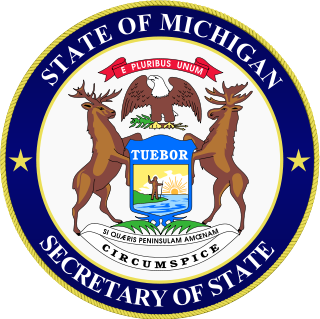
The governor of the State of Maryland is the head of government of Maryland, and is the commander-in-chief of the state's National Guard units. The governor is the highest-ranking official in the state and has a broad range of appointive powers in both the state and local governments, as specified by the Maryland Constitution. Because of the extent of these constitutional powers, the governor of Maryland has been ranked as being among the most powerful governors in the United States.

The governor of Oklahoma is the head of government of the U.S. state of Oklahoma. Under the Oklahoma Constitution, the governor serves as the head of the Oklahoma executive branch, of the government of Oklahoma. The governor is the ex officio commander-in-chief of the Oklahoma National Guard when not called into federal use. Despite being an executive branch official, the governor also holds legislative and judicial powers. The governor's responsibilities include making yearly "State of the State" addresses to the Oklahoma Legislature, submitting the annual state budget, ensuring that state laws are enforced, and that the peace is preserved. The governor's term is four years in length.

The North Carolina Secretary of State is an elected constitutional officer in the executive branch of the government of the U.S. state of North Carolina, and is fourth in the line of succession to the office of Governor of North Carolina. The secretary maintains the official journal of the North Carolina General Assembly and is responsible for overseeing land records, chartering corporations, and administering some commercial regulations. The incumbent is Elaine Marshall, a Democrat and the first woman elected to the office.

The secretary of state of California is the chief clerk of the U.S. state of California, overseeing a department of 500 people. The secretary of state is elected for four year terms, like the state's other constitutional officers; the officeholder is restricted by term limits to two terms. The current secretary of state is Shirley Weber, who assumed the role in 2021 after Alex Padilla's appointment to the US Senate.

The secretary of state of Minnesota is a constitutional officer in the executive branch of government of the U.S. state of Minnesota. Twenty-two individuals have held the office of secretary of state since statehood. The incumbent is Steve Simon, a DFLer.

The secretary of state is an official in the state governments of 47 of the 50 states of the United States, as well as Puerto Rico and other U.S. possessions. In Massachusetts, Pennsylvania, and Virginia, this official is called the secretary of the commonwealth. In states that have one, the secretary of state is the chief clerk of the state and is often the primary custodian of important state records. In the states of Alaska, Hawaii, and Utah, there is no secretary of state; in those states many duties that a secretary of state might normally execute fall within the domain of the lieutenant governor. Like the lieutenant governor, in most states, the secretary of state is in the line of succession to succeed the governor, in most cases immediately behind the lieutenant governor. In three states with no lieutenant governor as well as the U.S. territory of Puerto Rico, the secretary of state is first in the line of succession in the event of a gubernatorial vacancy.

The lieutenant governor of Nebraska is the highest-ranking executive official in the State of Nebraska after the governor. According to the Nebraska State Constitution, in the event a governor dies, becomes permanently incapacitated, resigns, or is removed from office, the lieutenant governor will become governor.

The Secretary of State of the State of Oklahoma is the chief clerical officer of Oklahoma and a member of the Oklahoma Governor's Cabinet. The Secretary of State is the only appointed constitutional member of the executive branch of the Oklahoma state government. The office of Secretary of State was elective from statehood until 1975 when the Constitution was amended and it became an appointive office, running concurrent with the Governor effective in 1979.

The Michigan Department of State is administered by the secretary of state, who is elected on a partisan ballot for a term of four years in gubernatorial elections.

The lieutenant governor of Indiana is a constitutional office in the US state of Indiana. Republican Suzanne Crouch, who assumed office January 9, 2017, is the incumbent. The office holder's constitutional roles are to serve as the president of the Indiana Senate, become acting governor during the incapacity of the governor, and become governor should the incumbent governor resign, die in office, or be impeached and removed from office. Lieutenant governors have succeeded ten governors following their deaths or resignations. The lieutenant governor holds statutory positions, serving as the head of the state agricultural and rural affairs bureaus, and as the chairman of several state committees.

The secretary of state of Vermont is one of five cabinet-level constitutional officers in the U.S. state of Vermont which are elected every two years. The secretary of state is fourth in the line of succession to the office of Governor of Vermont. The Office of the Secretary of State is located at 128 State St. in Montpelier. Since 2023, the secretary of state has been Sarah Copeland-Hanzas, a Democrat.

The secretary of state of Indiana is one of five constitutional officers originally designated in Indiana's state constitution of 1816. Since 1851, it has been an elected position. The secretary of state oversees four divisions, and is the third highest constitutional office of the state government. The secretary serves as the state's chief election officer, enforces state securities regulations, regulates automobile dealerships in Indiana, and manages the state business services division. The current office holder is Diego Morales.
The secretary of state of Wyoming is the state secretary of state of the U.S. state of Wyoming. It is a constitutional office, established under the Constitution of Wyoming and the secretary of state accedes to the governorship in case of a vacancy. The secretary of state is the keeper of the Great Seal of Wyoming and the state's official record-keeper. When the governor is traveling out-of-state, the secretary of state serves as acting governor. Karen Wheeler served as acting secretary of state following the vacancy of Ed Murray, until the appointment of Edward Buchanan in March, 2018, who himself resigned September 17, 2022.

The secretary of state of Arizona is an elected position in the U.S. state of Arizona. Since Arizona does not have a lieutenant governor, the secretary stands first in the line of succession to the governorship. The secretary also serves as acting governor whenever the governor is incapacitated or out of state. The secretary is the keeper of the Seal of Arizona and administers oaths of office. The current office holder is Democrat Adrian Fontes.

The secretary of state of Louisiana is one of the elected constitutional officers of the U.S. state of Louisiana and serves as the head of the Louisiana Department of State. The position was created by Article 4, Section 7 of the Louisiana Constitution.
The secretary of state of Alabama is one of the constitutional officers of the U.S. state of Alabama. The office actually predates the statehood of Alabama, dating back to the Alabama Territory. From 1819 to 1901, the secretary of state served a two-year term until the State Constitution was changed to set the term to four years. Up until 1868 the secretary of state was elected by the Alabama Legislature, but is now popularly elected. The terms and over 1,000 duties of the office are defined by Sections 114, 118, 132, and 134 of the Alabama Constitution and throughout the Code of Alabama.

The secretary of state of Nevada is a statewide elected office in the State of Nevada. The secretary of state post is common to many U.S. states. In Nevada, it is a constitutional office.
The secretary of state of Montana is one of the elected constitutional officers of executive branch of the U.S. state of Montana.

The secretary of state of New Mexico is a constitutional officer in the executive branch of government of the U.S. state of New Mexico. Twenty-six individuals have held the office of secretary of state since statehood. Since 1923, every elected New Mexican secretary of state has been a woman. The incumbent is Maggie Toulouse Oliver, a Democrat. Toulouse Oliver's election was forced early due to the resignation of former secretary of state Dianna Duran in October 2015, after criminal charges were filed by the Attorney General's Office alleging Duran converted campaign funds to personal gambling debt.

The secretary of state of West Virginia is an elected office within the U.S. state of West Virginia state government. The secretary of state is responsible for overseeing the state's election process, including voter registration and election results reporting.




























